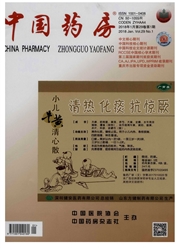

 中文摘要:
中文摘要:
目的:从传统抗炎中药中筛选具有拮抗细菌基因组DNA(Cytidine—phosphate—guanosine DNA,CpG DNA)活性的中药并对其进行活性物质含量的排序。方法:将CpG DNA包被于生物传感器的生物素样品池以建立靶点,测定114种中药水煎液去鞣质后与CpG DNA的亲和力;选择亲和力较高的35种药物与定量CpG DNA(16.5μg·mL^-1)于37℃混合孵育30min,再测定其与CpG DNA的亲和力,以评价药物水提液中活性物质的含量。结果:114种中药中,半枝莲、薄荷、侧柏叶等35种中药与CpG DNA具有较高亲和力(〉100RU);侧柏叶、地骨皮、大黄等19种中药与CpG DNA特异性结合的活性物质含量较高。结论:应用生物传感器跟踪检测技术筛选具有结合CpG DNA作用的中药具有可行性,筛选出的19种中药均含有非鞣质类能与CpG DNA发生特异性结合作用的活性物质。
 英文摘要:
英文摘要:
OBJECTIVE: To apply the biosensor technology to screen the anti - Cytidine - phosphate - guanosine DNA (CpG DNA) anti- inflammatory traditional Chinese medicines, and to sort them according to the contents of the active components. METHODS: CpG DNA was immobilized onto the surface of biotin cuvette for establishing target. The affinities of the tannins- removed aqueous extracts of 114 traditional Chinese medicines to CpG DNA were tested by affinity biosensor. 35 kinds of traditional Chinese medicines with high affinities to CpG DNA were incubated with CpG DNA (16.5μg · mL^-1) at 37 12 for 30 min, subsequently their affinities to CpG DNA were tested to evaluate the content of the active substance in the aqueous extractions of the TCM. RESULTS: Among the 114 Chinese traditional medicines, 35 such as scutellariae barbatae herba, mint, and biotae folium et ramulus showed higher binding activity to CpG DNA( 〉 100 RU), and 19 such as biotae folium et ramulus, lycium bark and rhubarb had higher contents of active substances that of specific affinity to CpG DNA. CONCLUSION : It is feasible to screen traditional Chinese medicine by biosensor technology. Nineteen kinds of TCM contain the active non - tannin substance with specific affinity to CpG DNA.
 同期刊论文项目
同期刊论文项目
 同项目期刊论文
同项目期刊论文
 期刊信息
期刊信息
